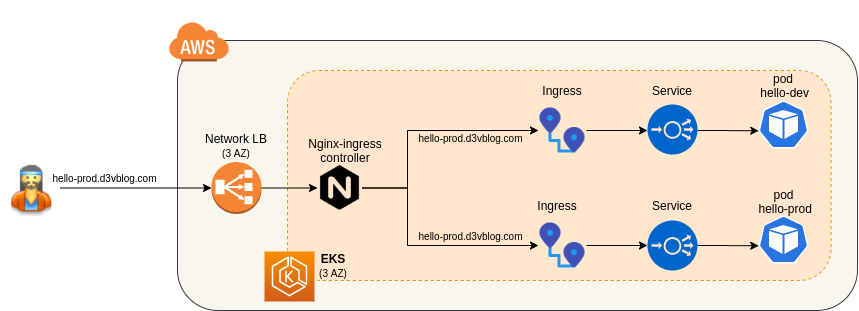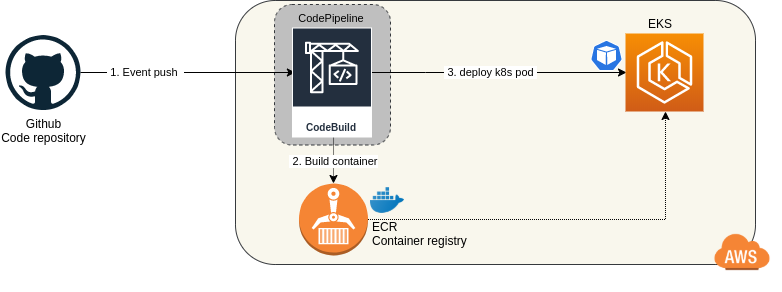This setup will deploy an EKS cluster in AWS, using CloudFormation. In this cluster, we will deploy a simple helloworld container, with automatic CI/CD from AWS PipeLine.
More info: you can find an overview of that setup on my blog
- Cloud: AWS
- EKS: managed Kubernetes container orchestrator (on 3 availability zones for redundancy)
- ECR: container registry to store hello image
- App: a simple hello world in nodejs (folder
hello) - Code source: Github
- Deployment: Terraform describes all components to be deployed. One command line will setup the infra
- CI/CD: Codepipeline to build and deploy the app in EKS
A simple git push from a developer in Github will launch the whole CI/CD process. Docker image will build and containers in EKS will be updated to run that new image without any downtime.
Please setup on your laptop:
- AWS cli and AWS account to deploy in
eu-west-1 - Docker and Compose
- Github personal token with
admin:repo_hook, reporights from here
Check the app locally:
cd hello
docker-compose up -d
curl localhost 8080
- Set a unique project prefix and your github token:
cd terraform
export TAG=hello-protos <-- please change to your prefix!
export GITHUBTOKEN=xxxx <-- You token here
nano buildspec-eks.yml <-- edit build vars
- Deploy EKS and CodePipeline:
terraform init
terraform apply -var gitHubToken=$GITHUBTOKEN -var tag=$TAG
- Cd
cd .. - Setup your kubeconfig:
aws eks --region eu-west-1 update-kubeconfig --name $TAG - Test:
kubectl get svc - Deploy hello app (using dockerhub hello image):
kubectl apply -f hello/hello.yml - Test the app by curling the public DNS
EXTERNAL-IP:PORTlisted here:kubectl get all - Curl:
curl acc43f4be4e5311eab2ed0e7ccd0f45b-1073317507.eu-west-3.elb.amazonaws.com:8080 - Delete deploy:
kubectl delete -f hello/hello.yml
- For CodeBuild IAM role to be able to deploy to EKS, you need to add a permission in EKS as described here
- Backup the configmap first:
kubectl get -o yaml -n kube-system configmap/aws-auth > aws-auth.yml - Edit it:
kubectl edit -n kube-system configmap/aws-auth - And replace with your build role ARN and add the block below the
mapUsers: |section :
- userarn: arn:aws:iam::[YOUR_ACCOUNT_ID]:role/[YOUR_TAG]-build-role
username: codebuild
groups:
- system:masters
- You can push code in the
masterand 'dev' branch which will triggerprodanddevpipelines. - After a successful build, check k8s services and pods:
kubectl get all
- Because we don't want each service
hello-dev&hello-prodto deploy each a external loadbalancer, we will use a uniqueingress-nginxcontroller. This ingress-controller will create an AWS NLB and link created ingress definitions
kubectl apply -f https://raw.githubusercontent.com/kubernetes/ingress-nginx/controller-0.32.0/deploy/static/provider/aws/deploy.yaml
kubectl -n ingress-nginx get svc <-- external DNS
kubectl get ingress
- Check your service using
curlandheaderto target dev or prod:
curl -H 'Host: hello-dev.d3vblog.com' ad96829dca62446fd8a14ab27eeb8bd7-e6993d978b08b7c1.elb.eu-west-1.amazonaws.com
Hello world *DEV* v3.6 from server: hello-dev-5c97c6dd6c-pqw9s%
curl -H 'Host: hello-prod.d3vblog.com' ad96829dca62446fd8a14ab27eeb8bd7-e6993d978b08b7c1.elb.eu-west-1.amazonaws.com
Hello world *PROD* v3.6 from server: hello-prod-d7566b444-4m97r%
To delete EKS, CodeBuild, CodePipeline (carefull, ALL will be deleted)
aws s3 rb s3://${TAG}-codebuild --force
aws s3 rb s3://${TAG}-codepipeline --force
cd terraform
terraform destroy
- Deploy with eksctl:
eksctl create cluster \
--name $TAG \
--version 1.14 \
--nodegroup-name standard-workers \
--node-type t2.medium \
--nodes 2 \
--nodes-min 2 \
--nodes-max 3 \
--node-ami auto
- To scale up the node:
eksctl scale nodegroup --cluster hello-terra-bkr --name standard-workers --nodes 4

